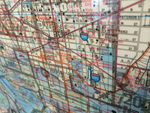Rabat's two major attractions stand opposite each other looking out over the Oued Bou Regreg. Le Tour Hassan (the Hassan Tower) was the towering minaret of the Hassan Mosque, which began construction in 1195 under the Almohad Yacoub el Mansour. Intended to be 60m high (200 ft.) -- and subsequently one of the tallest in the world -- the tower stands today at 44m (145 ft.), having been abandoned upon the death of the sultan in 1199. It's still a formidable structure and looms over the remains of its ruined mosque, flattened by an earthquake in 1755. The mosque was designed to hold 20,000 worshipers, and even though all that is left today are rows of reconstructed columns, the scale of its grandness is still visible.
Facing the tower is one of the country's most important shrines, the Mausoleum of Mohammed V, which is open to non-Muslims. Here lie the tombs of the nation's -- and the current king's -- grandfather, King Mohammed V, and his two sons King Hassan II and Prince Moulay Abdellah. Designed by a Vietnamese architect and inaugurated 6 years after Mohammed V's death in 1961, the building's surprisingly plain exterior white walls and green-tile roof betray an interior of exquisite traditional Moroccan craftsmanship. Mosaics of zellij rise from the marble floor to a ceiling of gold leaf and hand-carved cedar wood, while the three ground-floor tombs are carved from white onyx. The tomb of Mohammed V is flanked by those of his two sons, all of which are visible from an interior balcony and guarded by elaborately dressed royal guards and fez-topped security agents.
Next door is the Mohammed V Mosque, constructed at the same time and used mainly for Friday midday prayers and on important holy days. The whole complex, which encompasses Le Tour Hassan and the Mohammed V Mosque, is open daily and guarded by royal guards, who are mounted on steeds and are usually open to being photographed. It's a pleasant, though gradually uphill, 30-minute walk from most accommodations, though on humid summer days you might want to catch a petit taxi and then stroll back. Visitors should dress respectfully -- covering the shoulders and the knees -- and avoid coming between noon and 2pm, when the mausoleum closes for midday prayers in the adjoining mosque.





 About our rating system
About our rating system


